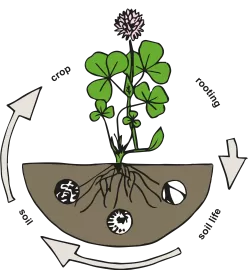Physical properties
If we talk about physiology we refer to the structure of a soil; the particle size, the pH, the water-buffering capacity, permeability, etc. It creates the basis from which soil life can procreate and live.
Roots make the soil
If we consider the three elements - chemistry, physiology and biology - the farmer's most important tool is his crop. The roots of every crop are able to make a massive contribution to optimising the soil, the physiology.
Is a root able to grow deep?
That depends on the soil structure - strong hard clumps, rounder and soft, or a wonderful crumb structure. Test it? Let the ground fall apart - do you get sharp, round corners or beautiful crumbs? (see photo below)
The formation of a good root system contributes to a healthy crop and to the soil structure, environment of the soil life and the availability of minerals.
An optimum soil consists of 50% sand, silt, clay fractions, and 50% water and air. Water and oxygen are important in an ecosystem. Compare it to humans - a human being can exist three weeks without food, three days without water and three minutes without oxygen. Biology is the most important cog in the soil. Water and oxygen are essential to life. So don't just focus on minerals, because a soil with the right conditions provides enough minerals of its own accord!
The roots create a web of tunnels and contribute to the physical properties. Roots form the hair roots that make the link to nutrition absorption. The plant feeds soil life with sugars and receives minerals in return, actively and passively.
With that in mind it is strange that nearly all fertilisers have salty properties. Put salt on a slug and we all know what happens…if you deactivate that zone, our crops simply move away from natural processes and become dependent on absorbing salts. Disrupting the natural process, one-sidedness, is a cause of quality issues in agriculture.
There is a major role for physiology and a crucial role for biology. Yield can only be achieved with the correct chemistry. Soil life is crucial to absorbing nutrients. The soil is the plant's stomach. How do we treat the stomach? What do we put into it? Which materials do we use to work the soil? The soil is vulnerable and requires care and attention.


Texture, structure, pores and water together determine the physical soil quality. Bearing capacity and penetration resistance are also important physical properties of the soil. Read more...


